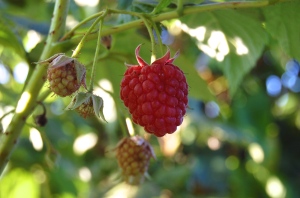
I love a good forage. What’s not to love? It’s free, fresh food with a bit of adventure thrown in for good measure. As soon as my daughter could walk, I had her out foraging, basket in hand. Now she’s that bit older, she thinks the garden and nearby fields and hedgerows are her own personal supermarket and I wouldn’t want it any other way.
It makes me sad when I hear children saying ‘I couldn’t possibly eat that because it might be poisonous’. That’s not their natural instincts talking: that’s the words of an over-anxious grown-up. It’s true there are things out there that can make you pretty ill, but they are few and far between and with a little bit of common sense, are easily avoided. I have an old, well-thumbed copy of Richard Mabey’s excellent Little Collins Gem Food for Free which you can still get in bookshops for under a fiver. It fits into your pocket and is a handy means of identifying anything you might be unsure of while you’re out and about.
I have a rule that if it’s the first time we’ve come across something, then my daughter double-checks with me to see if she can eat it. She already knows that most small red berries are not good to eat (at least raw, anyway) but easily identifiable raspberries and strawberries are fine. On our walks I can often hear her chatting away to herself like a little mantra: ‘No mouldy bits, no bugs…’ giving foraged finds a once over before popping it into her mouth.
There’s still plenty of free food out there at the moment if you know where to look. I probably should at this point mention that you shouldn’t take fruit from private land as it is illegal, but public rights of way, footpaths etc are fair game. I’m not sure anyone ever told my Grandad this though, as I lost count of the number of trees we climbed and fences we jumped to get to the best foraging grounds, which probably weren’t entirely legal if you interpreted the law to the letter.

Here in North East England at the moment apples are in abundance almost everywhere and while some can be eaten straight off the tree, others (like crab apples) are better cooked in jams or pies. Autumn raspberries and nuts such as hazelnuts can be found in hedgerows and there are edible greens such as chickweed and nettles literally under your feet.
Blackberries are still hanging in there too, and I like nothing better than to take a couple of baskets out with us to pick some apples and blackberries for a crumble. It’s the easiest thing in the world to make and little hands love to help make the crumble topping and pop blackberries in-between the holes of each apple ring.
- Make your crumble with half the amount of fat (butter always for me) to flour (use plain flour), sugar to taste, a handful of oats and rub together until it resembles breadcrumbs.
- Core and peel the apples and make into rings and lay on the bottom of an ovenproof dish, popping blackberries in-between and all over the layers as you build it up.
- Sprinkle with a bit of sugar and lemon juice to stop them discolouring.
- Put it in a medium oven at about 160-180 degrees, for about 45 mins.
I never exactly measure out a crumble as it depends on how much fruit I’ve got and how many mouths I need to feed, so don’t worry too much about being accurate. It’s also fun to experiment with different flavours in the crumble – a little ground cinnamon is good with apples, for example.
If you are picking mushrooms then do make sure you know exactly what you’re looking at and even ones that aren’t poisonous can disagree with some people, so it’s not something I’d personally risk with small children. It’s much better to go on an organised fungal walk with an expert.
Foraging is great fun as long as you take a few simple precautions such as avoiding taking anything from busy polluted roads (and who wants to forage there anyway with small people?) and don’t pick anything you’re not sure about. Also, don’t strip anything bare – leave enough for the birds and fellow foragers.
And I’ll just mention that, although my daughter will tell you firmly that sloes do not taste good raw and they’re not on the Top 10 list for foraging with children, they make an excellent flavoured gin for grown-ups and are available in a hedgerow near you now. Just look out for the prickly branches though – the scratches can be really nasty so I’d advise using gloves. I’d also recommend not popping into your local store on the way home to buy a bottle of gin on a Sunday afternoon with a small child in tow either. I think I’m still the talk of the village weeks on….
